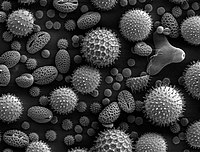
Photo from wikipedia
Abstract The article proposes a new methodology that combined light-assisted Scanning Surface Potential Microscopy (SSPM), Scanning Spreading Resistance Microscopy (SSRM) and Scanning Capacitance Microscopy (SCM) techniques for the extended nanoscale… Click to show full abstract
Abstract The article proposes a new methodology that combined light-assisted Scanning Surface Potential Microscopy (SSPM), Scanning Spreading Resistance Microscopy (SSRM) and Scanning Capacitance Microscopy (SCM) techniques for the extended nanoscale characterization of the electrical properties of AlGaN/GaN/Si heterostructures. Two measurement regimes were used to investigate the influence of surface defects on local electrical properties of samples: surface mapping with additional light excitation and one-point spectroscopy which enabled the accurate investigation of energetic transitions associated with a specific surface structure. The influence of two types of surface defects existing in the AlGaN/GaN/Si samples grown by metalorganic chemical vapour deposition epitaxy on the two-dimensional electron gas (2DEG) formation process on the AlGaN/GaN interface was explained. In the case of the sample with the SiN nanomasking layer added to the growth scheme, the areas of negative charge associated with defects created the localised, isolated islands that did not influence the process of electric field formation in the AlGaN/GaN system and had no significantly detrimental impact on the electron transport. The presence of surface defects in the sample without the SiN layer caused the disturbance of the 2DEG electrical properties not only in the place of the defect’s presence but also at some distance away from it. In that case, the photovoltage and photoconductivity spectra indicated the existence of a disordered structure of the AlGaN layer, near and away from the defects. Additionally, it was clarified that the characteristic electronic transition at 3.0 eV related to a deep trap state existing in the AlGaN barrier was localised solely at the surface site of the defects. It was observed during the SSRM measurements that both types of defects created a leakage current paths with prolonged conductivity (up to several seconds), which effect was not reported earlier, that provide an original insight into the origins of the long relaxation time effects existing in the AlGaN/GaN heterostructures.
Journal Title: Applied Surface Science
Year Published: 2021
Link to full text (if available)
Share on Social Media: Sign Up to like & get
recommendations!